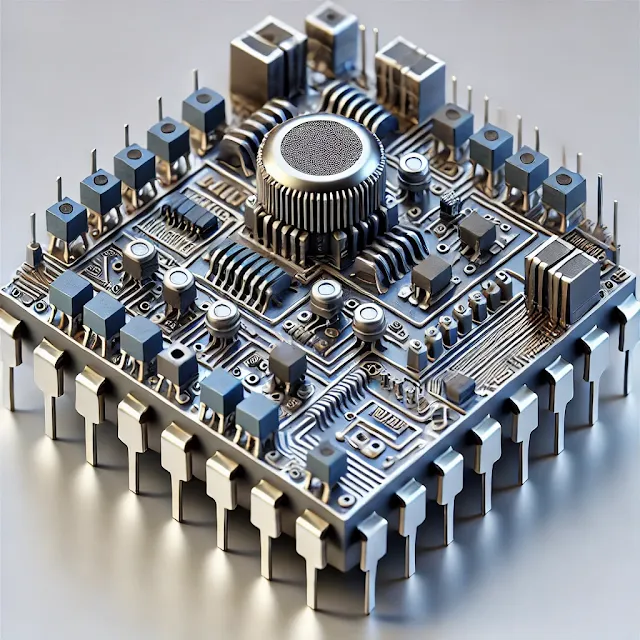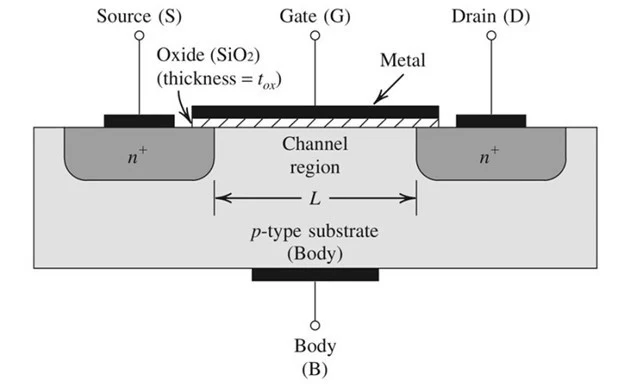What is a MOSFET?
A MOSFET (Metal-Oxide-Semiconductor Field-Effect Transistor) is a three-terminal semiconductor device that controls the flow of current using an electric field. It is a voltage-controlled device where the current between the drain and source terminals is regulated by the voltage applied to the gate terminal.
Structure of a MOSFET
A MOSFET consists of four main terminals:
- Gate (G): Controls the channel conductivity.
- Drain (D): The terminal through which current exits.
- Source (S): The terminal through which current enters.
- Body (B): The substrate to which the MOSFET is built (usually connected to the source).
The device is built on a p-type or n-type semiconductor substrate, with a thin silicon dioxide (SiO₂) layer insulating the gate from the channel. The thickness of this oxide layer plays a crucial role in determining the MOSFET’s performance.
Types of MOSFETs
MOSFETs can be classified into:
- Enhancement Mode MOSFET: Requires a positive gate voltage to induce a conductive channel.
- Depletion Mode MOSFET: Conducts by default and requires a negative gate voltage to turn off.
Both types can be further divided into N-Channel and P-Channel MOSFETs.
Working Principle of MOSFET
The operation of a MOSFET is governed by the electric field effect, where a voltage applied to the gate terminal controls the current flow between the source and drain.
MOSFET Current Equation
The MOSFET operation can be divided into three regions:
1. Cut-off Region (OFF State)
In this region, the MOSFET is turned off, and no current flows from the drain to the source. This happens when the gate-to-source voltage (VGS) is below the threshold voltage (Vth).
2. Linear (Ohmic) Region
When VGS> Vth, a conductive channel is formed, and the MOSFET behaves like a resistor. The drain current is proportional to the applied drain-to-source voltage (VDS), and is given by:
where:
- = Mobility of electrons (for N-channel MOSFET)
- = Oxide capacitance per unit area
- = Channel width
- = Channel length
- = Threshold voltage
3. Saturation (Active) Region
In this mode, the MOSFET acts as a constant current source, and the drain current is approximately given by:
In this state, VDS > (VGS - Vth), and the MOSFET is widely used in amplifier circuits.
Applications of MOSFET
1. Power Electronics
- Used in Switch-Mode Power Supplies (SMPS) for efficient power conversion.
- Essential in DC-DC converters and inverters.
- Applied in motor control circuits.
2. Digital Circuits & Microprocessors
- Used in CMOS technology for logic gates in microcontrollers and CPUs.
- Employed in memory devices such as DRAM and SRAM.
3. RF & Analog Circuits
- MOSFETs are used in low-noise amplifiers (LNA).
- Found in radio-frequency (RF) oscillators.
4. Automotive Electronics
- Applied in Electric Vehicle (EV) powertrains.
- Used in battery management systems (BMS).
5. Audio Amplifiers
- MOSFETs provide high linearity and low distortion in high-fidelity amplifiers.
Frequently Asked Questions (FAQs)
1. Why is MOSFET preferred over BJT?
MOSFETs are preferred due to:
- Higher switching speed.
- Lower power consumption.
- Higher input impedance.
- Better thermal stability.
2. How do you select a MOSFET for a circuit?
Consider the following parameters:
- Voltage ratings (VDS, VGS).
- Current rating (ID).
- RDS(on) (Drain-Source resistance).
- Switching speed (rise/fall time).
- Thermal dissipation capability.
3. What is the difference between N-Channel and P-Channel MOSFETs?
- N-Channel MOSFETs: Use electrons as charge carriers, have lower resistance, and are more efficient.
- P-Channel MOSFETs: Use holes as charge carriers, have higher resistance but are useful for certain configurations.
4. Can MOSFETs be used as amplifiers?
Yes, MOSFETs are used in:
- Common source amplifiers (high gain).
- Common drain amplifiers (buffer stages).
- Common gate amplifiers (high-frequency applications).
5. What is the role of a MOSFET gate driver?
A MOSFET gate driver provides the necessary voltage and current to switch the MOSFET efficiently, reducing switching losses and improving performance.
Conclusion
MOSFETs are indispensable components in modern electronics due to their superior efficiency and fast switching characteristics. Understanding their working principle, types, and applications helps in selecting the right MOSFET for specific applications. As new materials like Gallium Nitride (GaN) and Silicon Carbide (SiC) emerge, MOSFETs continue to revolutionize power electronics and high-performance applications.




